The Indian Elephant is widely seen in 16 of the 28 states of India, especially in the Southern part of the Western Ghats, North-Eastern India, Eastern India, Central India, and Northern India.
Elephant Reserves in India
World Elephant Day is celebrated on 12th August every year to spread awareness for the conservation and protection of the largest mammal on land.
The day was launched in 2012 to bring attention to the urgent plight of Asian and African elephants.
- Elephants
- Elephants have the longest gestation period of any mammal—22 months. Females give birth every four to five years.
- Elephant herds have complex social structures, are led by matriarchs, and are comprised of a group of other adult females and calves, while male elephants tend to live in isolation or small bachelor groups.
- An elephant trunk has up to 40,000 muscles. [A human has more than 600 muscles in the entire body.]
- Elephant tusks are actually teeth, once a tusk is broken, damaged, or removed, it stays that way [i.e. can not grow back].
- Asian Elephants: There are three subspecies of Asian elephants which are the Indian, Sumatran, and Sri Lankan.
- Global Population: Estimated 20,000 to 40,000.
- The Indian subspecies has the widest range and accounts for the majority of the remaining elephants on the continent.
- There are around 28,000 elephants in India with around 25% of them in Karnataka.
- IUCN Red List Status: Endangered.
- Wildlife (Protection) Act, 1972: Schedule I.
- CITES status – Appendix I.
- African Elephants: There are two subspecies of African elephants, the Savanna (or bush) elephant, and the Forest elephant.
- Global Population: Around 4,00,000.
- IUCN Red List Status:
- African Forest elephant: critically endangered
- Savanna elephant: endangered
- Earlier in July 2020, Botswana (Africa) witnessed the death of hundreds of elephants.
- Difference between Asian and African elephants
- Asian elephants are smaller than their African cousins, and their ears are smaller compared to the large fan-shaped ears of the African species.
- Only some male Asian elephants have tusks, while both male and female African elephants grow tusks.
- It is also important to note that there are two distinct elephant species on the African continent—the savanna elephant and the forest elephant, with a number of characteristics that differentiate them both as well.
Project Elephant
- Tiger faces threat of extinction, whereas the elephant faces threat of attrition.
- The elephant numbers have not increased or decreased drastically but there is increasing pressure on the elephant habitats.
- Project Elephant was launched in 1992. It is a centrally sponsored scheme.
- To protect elephants, their habitat & corridors.
- To address issues of man-animal conflict.
- The welfare of captive elephants.
- The elephant census is conducted once in 5 years under the aegis of Project elephant.
- The direct elephant counting method is based on the sightings of elephants.
- In the indirect method, surveyors follow a dung decay formula for arriving at population estimation which is being used by Tamil Nadu and Karnataka at present.
- A variation of about 8% to 9% has been noticed between the two methods.
- Karnataka has the highest number of elephants (6,049), followed by Assam (5,719) and Kerala (5706).
Objectives:
- to assist states having populations of wild elephants and to ensure long term survival of identified viable populations of elephants in their natural habitats
- addressing man-animal conflict.
- Developing scientific and planned management measures for the conservation of elephants.
- Protecting the elephants from poachers, preventing illegal ivory trade, and other unnatural causes of death
Project RE-HAB
- A pilot project RE-HAB (Reducing Elephant-Human Attacks using Bees) has been launched in Karnataka which entails installing bee boxes along the periphery of the forest and the villages to mitigate human-elephant conflict.
- These spots are located on the periphery of Nagarahole National Park and Tiger Reserve, which is a known conflict zone.
- It is intended to create “bee fences” to thwart elephant attacks in human habitations using honeybees.
- Implementing Agency:
- The project is an initiative of the Khadi and Village Industries Commission (KVIC).
- It is a sub-mission of KVIC’s National Honey Mission.
Khadi and Village Industries Commission
- KVIC is a statutory body established under the Khadi and Village Industries Commission Act, 1956.
- The KVIC is charged with the planning, promotion, organization, and implementation of programmes for the development of Khadi and other village industries in the rural areas in coordination with other agencies engaged in rural development wherever necessary.
- It functions under the Ministry of Micro, Small, and Medium Enterprises.
Elephant Corridor
- An elephant corridor is defined as a stretch/narrow strips of forested (or otherwise) land that connects larger habitats with elephant populations and forms a conduit for animal movement between the habitats.
- This movement helps enhance species survival and birth rate.
- There are 88 identified elephant corridors in India.
- Out of the total of 88 corridors,
- 20 are in south India,
- 12 in north-western India,
- 20 in central India,
- 14 in northern West Bengal, and
- 22 in north-eastern India.
Threats to Elephant Corridors
- Habitat loss leading to fragmentation and destruction caused by developmental activities like construction of buildings, roads, railways, holiday resorts, and fixing solar energized electric fencing, etc.
- Coal mining and iron ore mining is the two “single biggest threats” to elephant corridors in central India.
- Orissa, Jharkhand, and Chhattisgarh are mineral-rich states, but also have the highest number of elephant corridors in the country, which makes them known for elephant-man conflicts.
- There is also a serious poaching problem, as elephant ivory from the tusks is extremely valuable.
- Elephants need extensive grazing grounds and most reserves cannot accommodate them. If protected areas are not large enough, elephants may search for food elsewhere. This often results in conflicts with humans, due to elephants raiding or destroying crops.
Mitigation
- The fusion of the corridors with nearby protected areas wherever feasible; in other cases, declaration as Ecologically Sensitive Areas or conservation reserves to grant protection.
- During the process of securing a corridor, monitoring for animal movement has to be carried out; depending on the need, habitat restoration work shall also be done.
- Securing the corridors involves sensitizing local communities to the option of voluntarily relocation outside the conflict zones to safer areas.
- Preventing further fragmentation of the continuous forest habitat by encroachment from urban areas.
Initiatives for protecting elephants
Monitoring of Illegal Killing of Elephants (MIKE) Programme
- The MIKE Programme was established by a CITES Resolution adopted at the CoP10 in 1997.
- MIKE is an international collaboration that measures the levels, trends, and causes of elephant mortality.
- MIKE’s information base is used to support international decision-making related to the conservation of elephants in Asia and Africa.
- The information and analyses are also presented at annual CITES meetings and meetings of the CoPs.
- One of the core mandates given to the MIKE Programme is to build capacity in elephant range States.
- Mandated by COP resolution of CITES, MIKE program started in South Asiain the year 2003 with the following purpose:
- To provide the information needed for elephant range States to make appropriate management and enforcement decisions, and
- to build institutional capacity within the range States for the long-term management of their elephant populations
- MIKE is entirely dependent on donor support. The European Union has been the most important donor for the MIKE programme in Africa since 2001, and in Asia since 2017.
Objectives–
- To measure the levels and trends in illegal poaching and ensure changes in the trends for elephant protection.
- To determine the factors responsible for such changes, and to assess the impact of decisions by the conference of parties to CITES.
MIKE sites & MIKE Sites in India
- There are around 50 MIKE sites across Africa.
- There are currently 28 sites participating in the MIKE program in Asia, distributed across 13 countries
- India has 10 sites
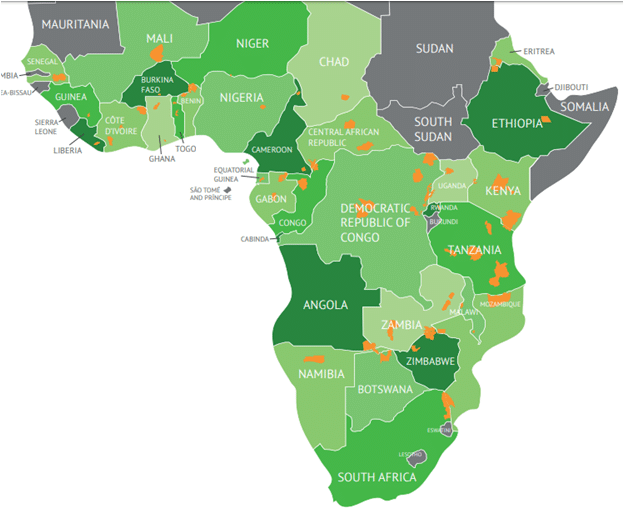
MIKE Sites in India
- Chirang-Ripu Elephant Reserve
- Dihing Patkai Elephant Reserve
- Eastern Dooars Elephant Reserve
- Deomali Elephant Reserve
- Garo Hills Elephant Reserve
- Mayurbhanj Elephant Reserve
- Shivalik Elephant Reserve
- Mysore Elephant Reserve
- Nilgiri Elephant Reserve
- Wayanad Elephant Reserve
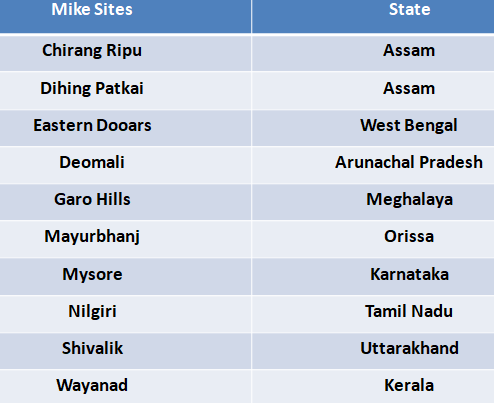
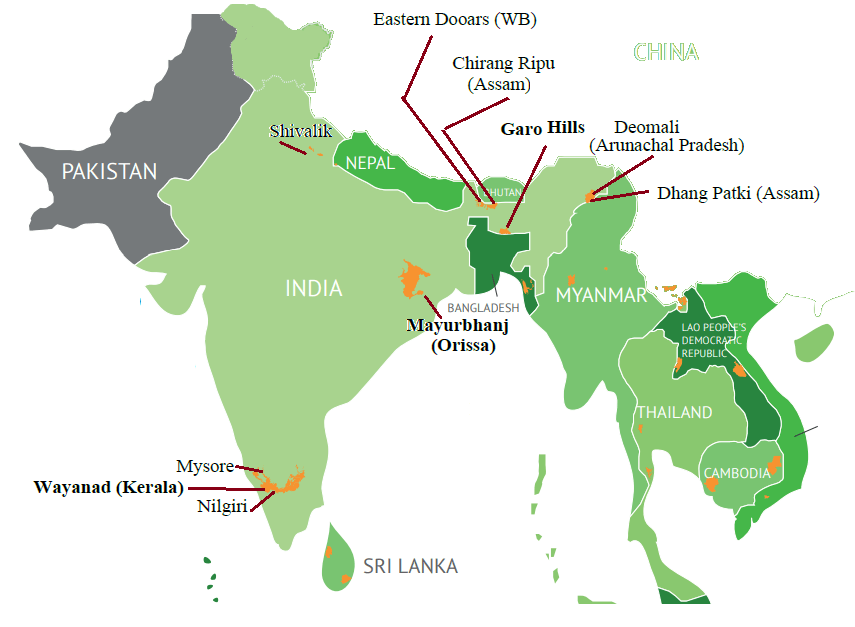
Haathi Mere Saathi
- Haathi Mere Saathi is a campaign launched by the Ministry of environment and forest (MoEF) in partnership with the wildlife trust of India (WTI).
- The campaign was launched at the “Elephant- 8” Ministerial meeting held in Delhi in 2011.
- The E-8 countries comprise India, Botswana, the Republic of Congo, Indonesia, Kenya, Srilanka, Tanzania, and Thailand.
- This public initiative was aimed at increasing awareness among people and developing friendship, companionship between people and elephants.
Elephant Task Force
- The Union government constituted an Elephant Task Force (ETF) in 2010 under the leadership of historian Mahesh Rangarajan to review the existing policy of elephant conservation in India and formulate future interventions.
- The task force came out with a comprehensive report in August that year, called Gajah: Securing the Future for Elephants in India.
- The ETF was headed by a wildlife historian and political analyst, Dr. Mahesh Rangarajan. And the other members included were conservation and animal welfare activists, elephant biologists, and a veterinarian.
- The focus of the Elephant Task Force was to bring pragmatic solutions for the conservation of elephants in the long-term.
- India has around 25000 – 29000 elephants in the wild. However, the tuskers (male) in India are as threatened as the Tigers as there are only around 1200 tusker elephants left in India.
- The Asian elephants are threatened by habitat degradation, man-elephant conflict, and poaching for the Ivory. This problem is more intense in India which has around 50% of the total population of the world’s Asian elephants.
List of Elephant Reserves in India
As notified by the government, there are around 33 elephant Reserves in India. The very first elephant reserve or elephant sanctuary was the Singhbhum Elephant Reserve of Jharkhand.
The List of Elephant reserves in India is as mentioned below:
| Zone | State | Elephant Reserves |
|---|---|---|
| North-Western Landscape | Uttrakhand | Shivalik Elephant Reserve |
| Uttar Pradesh | Uttar Pradesh Elephant Reserve Terai Elephant Reserve | |
| East-Central Landscape | West Bengal | Mayurjharna Elephant Reserve |
| Jharkhand | Singhbhum Elephant Reserve | |
| Orissa | Mayurbhanj Elephant Reserve Mahanadi Elephant Reserve Sambalpur Elephant Reserve | |
| Chhattisgarh | Lemru Elephant Reserve Badalkhol-Tamor Pingla ER | |
| Kameng- Sonitpur Landscape | Arunachal Pradesh | Kameng Elephant Reserve |
| Assam | Sonitpur Elephant Reserve | |
| Eastern-South Bank Landscape | Assam | Dihing-Patkai Elephant Reserve |
| Arunachal Pradesh | South Arunachal Elephant Reserve | |
| Kaziranga-Karbi Anglong-Intanki Landscape | Assam | Kaziranga-Karbi Anglong ER Dhansiri-Lungding ER |
| Nagaland | Intanki Elephant Reserve Singphan Elephant Reserve | |
| North Bengal-Greater Manas Landscape | Assam | Chirang-Ripu Elephant Reserve |
| West Bengal | Eastern Dooars ER | |
| Meghalaya Landscape | Meghalaya | Garo Hills Elephant Reserve Khasi-hills Elephant Reserve |
| Brahmagiri-Nilgiri-Eastern Ghats Landscape | Karnataka | Mysore Elephant Reserve Dandeli Elephant Reserve |
| Kerala | Wayanad Elephant Reserve Nilambur Elephant Reserve | |
| Tamil Nadu | Coimbatore Elephant Reserve Nilgiri Elephant Reserve | |
| Andhra Pradesh | Rayala Elephant Reserve | |
| Annamalai- Nelliyampathy-High Range Landscape | Tamil Nadu | Annamalai Elephant Reserve |
| Kerala | Anamudi Elephant Reserve | |
| Periyar- Agasthyamalai Landscape | Kerala | Periyar Elephant Reserve |
| Tamil Nadu | Srivilliputhur Elephant Reserve | |
| Tamil Nadu | Agasthyamalai Elephant Reserve |
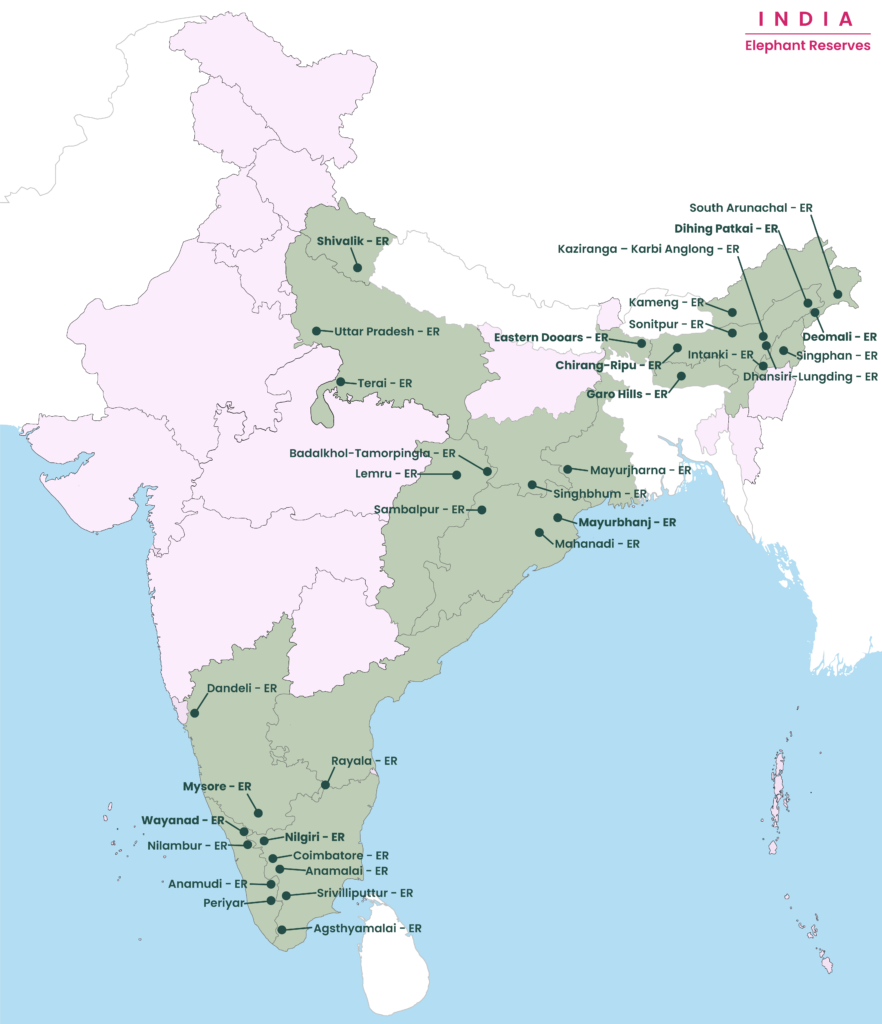
State-wise Elephant Reserves in India
| Elephant Reserve | State | Total Area(Sq. Km) |
|---|---|---|
| Rayala ER | Andhra Pradesh | 766 |
| Kameng ER | Arunachal Pradesh | 1892 |
| South Arunachal ER | Arunachal Pradesh | 1957.50 |
| Sonitpur ER | Assam | 1420 |
| Dihing-Patkai ER | Assam | 937 |
| Kaziranga – Karbi Anglong ER | Assam | 3270 |
| Dhansiri-Lungding ER | Assam | 2740 |
| Chirang-Ripu ER | Assam | 2600 |
| Badalkhol-Tamorpingla | Chhattisgarh | 1048.30 |
| Lemru ER | Chhattisgarh | 450 |
| Singhbhum ER | Jharkhand | 4530 |
| Mysore ER | Karnataka | 6724 |
| Dandeli ER | Karnataka | 2,321 |
| Wayanad ER | Kerala | 1200 |
| Nilambur ER | Kerala | 1419 |
| Anamudi ER | Kerala | 3728 |
| Periyar | Kerala | 3742 |
| Garo Hills ER | Meghalaya | 3,500 |
| Intanki ER | Nagaland | 202 |
| Singphan ER | Nagaland | 23.57 |
| Mayurbhanj ER | Odisha | 3214 |
| Mahanadi ER | Odisha | 1038 |
| Sambalpur ER | Odisha | 427 |
| Nilgiri ER | Tamil Nadu | 4663 |
| Coimbatore ER | Tamil Nadu | 566 |
| Anamalai ER | Tamil Nadu | 1457 |
| Srivilliputtur ER | Tamil Nadu | 1249 |
| Agsthyamalai ER | Tamil Nadu | 1,197.48 |
| Uttar Pradesh ER | Uttar Pradesh | 744 |
| Terai ER | Uttar Pradesh | 3049 |
| Shivalik ER | Uttarakhand | 5405 |
| Mayurjharna ER | West Bengal | 414 |
| Eastern Dooars ER | West Bengal | 978 |
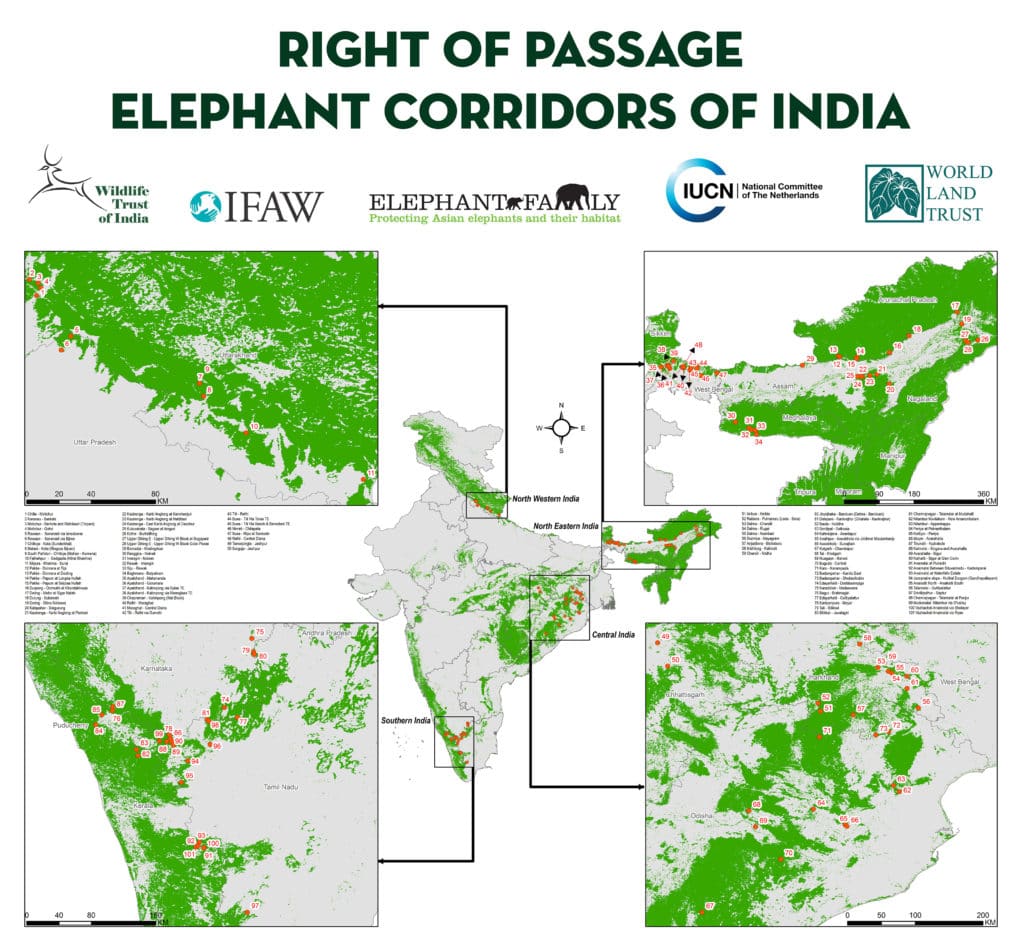
Kameng Elephant Reserve
- Kameng Elephant Reserve is established in June 2002 in the Himalayan foothills of West Kameng and East Kameng Districts of Arunachal Pradesh.
- It includes Sessa Orchid Sanctuary in the north, Eaglenest Wildlife Sanctuary in the west, Pakhui Tiger Reserve across the Kameng River to the east, and reserved forests under Khellong Forest Division.
Shivalik Elephant Reserve
- It was notified in 2002 under the ‘Project Elephant’.
- The Kansora-Barkot Elephant Corridor is located near to it.
- It is considered to have one of the highest densities of elephants found in India.
- The Indian elephant (Elephas maximus) occurs in the central and southern Western Ghats, North-east India, eastern India, and northern India, and in some parts of southern peninsular India.
- As per the Elephant Census, 2017, Karnataka has the highest population of Indian elephants.
Lemru Elephant Reserve
- The reserve is located in the Korba district of Chhattisgarh.
Agasthyamalai Elephant Reserve
- It is the 32nd elephant reserve in the country and the fifth in Tamil Nadu.
Terai Elephant Reserve
- It is located in Pilibhit district of Uttar Pradesh and was notified as a tiger reserve in 2014.
- It is spread in a 3,049 sq km area, including Dudhwa Tiger Reserve (DTR) and Pilibhit Tiger Reserve (PTR), Kishanpur Wildlife Sanctuary (KWS), Katarniaghat Wildlife Sanctuary (KGWS), Dudhwa buffer zone and parts of south Kheri forest division”.
- It is the second elephant reserve in UP and India’s 33rd.

To the point: Upsc content.
Nyc 👍
Very useful.
adorable work by lotus arise.
all the required content at one place.
tq so much for this help
God level of content thanks team Lotus arise
your list missed the singhphan hills, terai and dandeli hills. also mistakenly added khasi hills, baitami,south odisa
reference
http://www.wiienvis.nic.in/Database/ElephantReserves_8226.aspx